Dear Maasi: How can I stop the trauma of FGM/C from popping into my mind?

Dear Maasi is a column about everything you wanted to know about sex and relationships but were afraid to ask! It’s a partnership between Sahiyo and WeSpeakOut, and is for all of us who have questions about khatna (female genital mutilation/cutting or FGM/C) and how it impacts our bodies, minds, sexualities and relationships. We welcome you to submit your anonymous questions. Dear Maasi, Although I’ve emotionally resolved much about the FGM/C trauma through therapy, there are times when it pops into my mind in an unexpected way, for example, the odd time when I’m urinating. It might be a depressing thought, or a prickly pain down there. At these moments, I feel awful and sad, and angry that FGM/C can still intrude upon my life. How can I stop it? —Mariam Dear Mariam, Thank you for this important question. Sometimes our FGM/C trauma and their triggers can feel difficult to understand. In my April 2021 column, I talked about this: “Trauma memories are often implicit, because trauma floods our brain with cortisol, the stress hormone, which shuts down the part of our brain that encodes memories and makes them explicit. Our implicit memories can be like invisible forces in our lives, impacting us in powerful ways.” (https://www.psychalive.org/making-sense-of-implicit-memories/) These “invisible forces” show up in the ways you’ve described, in those seemingly random moments when you’re not expecting them to. Trauma impacts both our mind and body and can keep our nervous systems on alert for perceived threats, even when there is no actual threat present. Frustrating right? I am not sure that we can stop it, but we can lessen the suffering. One powerful strategy is mindfulness, which originated in eastern and Buddhist philosophy and uses moment-to-moment awareness to cope and reduce distress. Mindfulness has helped me when I have uncomfortable thoughts, feelings, or bodily experiences. For example, when I feel discomfort in my genitals, I have learned (with a therapist’s help, reading, and lots of practice) to respond to it as a neutral sensation. The goal is to acknowledge the sensation without reacting negatively. How we respond and talk to ourselves matters. -I might say “Oh! There’s that sensation in my vulva” or “Oh! There’s that memory” versus “Oh! There’s that awful/weird/unpleasant pain” or “Oh! There’s that horrible memory that will never go away”. -I’ll then breathe into the sensation or memory, and send love to my body or mind. When I first tried this exercise, it didn’t work immediately, or feel believable; in time, with lots of repetition, it started to work. This is because the repetitive practice builds new neural networks that allow us to have new responses. One way to remember to practice is to post a picture or words that will help you remember. Mariam, in your case, you could post this reminder in the bathroom, right across from the toilet. Hope this helps, Mariam. And as always, remember that sexual pleasure and healing is our birthright! —Maasi About Maasi, aka Farzana Doctor: Farzana is a novelist and psychotherapist in private practice. She’s a founding member of WeSpeakOut and the End FGM/C Canada Network. She loves talking about relationships and sexuality! Find out more about her at http://www.farzanadoctor.com Disclaimer: While Farzana is full of good advice, this column won’t address everyone’s individual concerns and should not be used as a substitute for professional medical or psychological care.
Connecticut Trauma and Gender Learning Collaborative Training Part 2
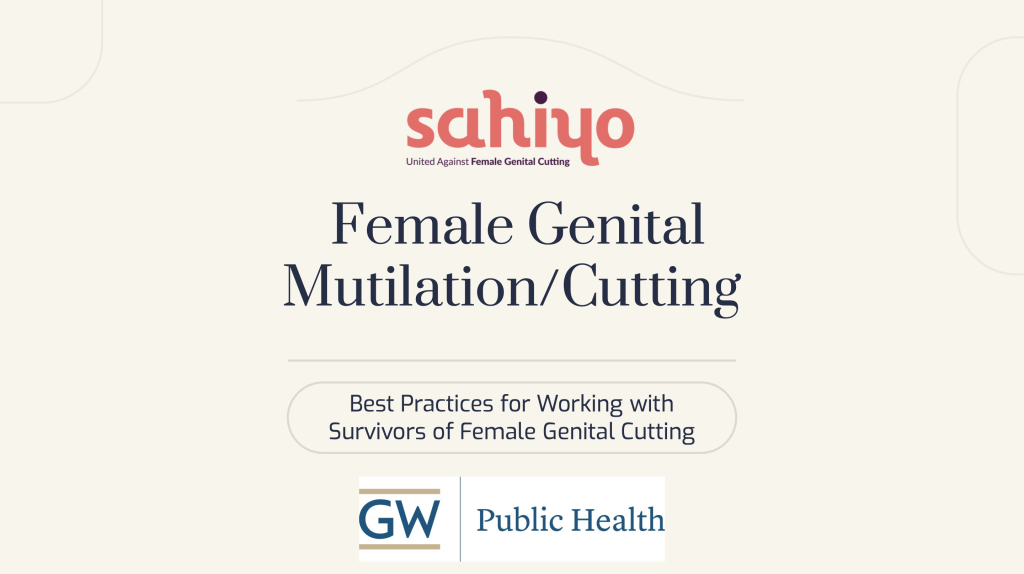
On February 3rd, Sahiyo Co-Founder Mariya Taher joined Dr. Karen McDonnell from George Washington for our second training for the Connecticut Trauma and Gender Learning Collaborative (TAG). TAG is a collaboration between the Department of Mental Health and Addiction Services (DMHAS), the Connecticut Women’s Consortium (CWC), and other healthcare providers in Connecticut. TAG aims to promote best practices in trauma-informed, gender-responsive behavioral health care in Connecticut by providing training, consultation, and information to behavioral health agencies across the state. During this presentation, Sahiyo continued to explore FGM/C in the United States, and discussed various resources available for clinicians and other front-line professionals who may come in contact with women impacted by FGC, and are looking to better understand how to provide trauma-informed care while practicing cultural competence and sensitivity.
डियर मासी: एक ट्रॉमा थेरेपिस्ट से बात करना क्यों ज़रूरी है

डियर मासी एक ऐसा कॉलम है, जिसमें सेक्स और रिश्तों के बारे में वह सब कुछ बताया गया है जो आप जानना तो चाहते हैं, लेकिन पूछने से डरते हैं! यह सहियो और वी स्पीक आउट इन दो संगठनों ने मिलकर बनाया है। यह कॉलम उन लोगों के लिए है जिन्हें महिला जननांग काटने या खतना के बारे में सवाल है। यह कॉलम ख़तना कैसे हमारे शरीर, दिल, दिमाग, लैंगिकता और रिश्तों पर असर करता है इसके बारे में भी बात करता हैं। बोहरा समाज के सन्दर्भ में, माँ की बहन मासी हैं। आपके सवालों का हम स्वागत करते हैं। अपने सवाल बेझिझक यहाँ पर भेजिए। अपनी पेहचान गुप्त भी रख सक्ते हैं| प्यारी मासी, मैं 26 साल की हूँ और मेरी जिंदगी में तीन गहरे रिश्ते रहे हैं (दो लड़के और हाल ही में एक औरत के साथ)। मुझे आत्मीयता पसंद है, लेकिन पेनीट्रेशन (किसी भी चीज के साथ) से अक्सर दर्द होता है। मैंने कभी-कभी सेक्स से पूरी तरह परहेज किया है और इससे मेरे रिश्तों में तनाव पैदा हुआ है। जब मैंने एक डॉक्टर को दिखाया तो उन्होंने कहा था कि सब कुछ सामान्य है। लेकिन सच कहूँ तो मैं वाकई असामान्य महसूस करती हूँ। मेरा खतना हुआ था और मैं सोच रही हूँ कि क्या इसका मुझ पर कोई असर पड़ा है। लेकिन मुझे कुछ समझ में नहीं आ रहा है क्योंकि उन्होंने मेरे भगशेफ छत्र (क्लिटोरल हुड) को काट दिया- उन्होंने मेरी योनि को नुकसान नहीं पहुँचाया, है ना? —डरी हुई फ़ातेमा प्यारी फ़ातेमा, सबसे पहले – मैं चाहती हूँ आप यह जान लें कि आप जिस बारे में बात कर रहीं हैं वह कोई गैर-मामूली चीज नहीं है बल्कि एक मामूली-सी बात है। पेनीट्रेटिव सेक्स से दर्द होने के बहुत से कारण है। हार्मोन के कारण सूखापन, योनि में संक्रमण, चोट, और श्रोणी सूजन की बीमारी, फाइब्रॉइड्स या एंडोमेट्रियोसिस जैसे हालात की वजहों से यह हो सकता है। दर्द के अन्य सामान्य कारण हैं – योनि का जकडन (पेनीट्रेशन पर योनि या श्रोणि तल की मांसपेशियों में ऐंठन या जकड़न होना) या वेस्टिबुलर वल्वाइटिस (योनि छेद के आसपास की नसों के आसपास सूजन)। इन्हें सदमे से जोड़ा जा सकता है। इस पर थोड़ा आगे और बात करेंगे। मेरा सुझाव है कि आप दूसरे डॉक्टर से भी राय लें। बहुत सारे डॉक्टर लैंगिकता के बारे में बात करने से झिझकते हैं, और ठीक से जांच नहीं करते है। किसी ऐसे डॉक्टर की तलाश करें जिन्हें यौन मुश्किलात पे काम करने का तजुर्बा हो। इस मुद्दे को गहराई से समझने के लिए आप बॉडी पॉडकास्ट के एपिसोड वन को सुनने की मैं सिफ़ारिश करती हूँ। जहाँ तक खतना और आपके दर्द के बारे में आपका सवाल है, तो खतना में योनि नहीं काटी जाती बल्कि भगशेफ छत्र (क्लिटरिअल हुड) और कभी-कभी भगशेफ (क्लिटरिस) को भी काटा जाता है। फिर भी, शोध से पता चला है कि यह काटने से लैंगिकता पर असर हो सकता है: 2017 में किए गए सहियो सर्वे में, 35% जवाबदाताओं ने बताया कि खतना से उनके यौन जीवन पर असर हुआ था और उनमें से 87% ने महसूस किया कि यह असर बुरा था। 2018 के वी स्पीक आउट स्टडी में, तक़रीबन 33% जवाबदाताओं ने ऐसा ही कहा। मैं उनके कुछ हवालों को पढ़ने की सिफ़ारिश करती हूँ जो दर्द, ट्रिगर और सदमे को बयां करते हैं (पन्ने- 47 से 60 तक)। पढ़ने पर यह आपके अनुभव जैसे लग सकते है। सदमा तकलीफ़देह घटना का नतीजा होता है। यह किसी बात का डटकर मुकाबला करने और तजुर्बे को समझने की हमारी क़ाबलियत पर असर डालता है। ज्यादातर सरवाईवर्स खतना को एक परेशान करने वाला, पेचीदा और दर्दनाक तजुर्बा बताते हैं। इसमें कभी-कभी इनकार, गैसलाइटिंग जैसी मनोवैज्ञानिक जोड़तोड़ या बड़े-बूढ़े, भरोसेमंद रिश्तेदारों का झूठ भी शामिल होता है। मैं कहूँगी कि खतना एक सदमा ही होता है और वह उसकी व्याख्या में बैठता है। हमारा दिमाग और जिस्म सदमे को इस तरह से पकड़कर रख सकते हैं जो कभी-कभी परोक्ष या पेचीदा लगता है। मेरा मतलब समझने के लिए इस कॉमिक पर एक नज़र डालें। अब मेरी समझ में आता है कि खतना से हमारे बाहरी गुप्तांग (वल्वा) और योनि में तनाव हो सकता है। खतना ने आप पर इस तरह से असर किया है या नहीं यह समझने के लिए किसी ऐसे थेरेपिस्ट से बात करें जो सदमे पे स्पेशलिस्ट हो । फ़ातेमा, आप यह जानें कि इससे वापिस सेहतमंद और ठीक होना मुमकिन है। आपको ख़ुशी से भरपूर यौन जिंदगी का हक़ है! —मासी मासी उर्फ फ़रज़ाना डॉक्टर के बारे में फ़रज़ाना एक उपन्यास लेखिका हैं और मनोचिकित्सक की प्राइवेट प्रैक्टिस करती हैं। वह WeSpeakOut और End FGM/C कनाडा नेटवर्क की संस्थापक सदस्य हैं। वह रिश्तों और लैंगिकता के बारे में बात करना पसंद करती है! www.farzanadoctor.com पर उनके बारे में और मालूमात करें। दाऊदी बोहरा समुदाय के बारे में औरतों के रिश्तों, लैंगिकता, बेवफाई और खतना पर चर्चा करने वाला उनका नया नावेल, सेवन ऑर्डर करें। अस्वीकरण: फ़रज़ाना अच्छी सलाह जरुर देती है, लेकिन यह कॉलम हर किसी के निजी सवालों पर बात नहीं करता है और इसे पेशेवर चिकित्सा या मनोवैज्ञानिक देखभाल के विकल्प के रूप में इस्तेमाल नहीं किया जाना चाहिए। Read the Gujarati translation here, and the English translation here.
My experience of learning about female genital cutting: An outsider’s perspective

By Madrisha Debnath Not belonging to a community where female genital cutting (FGC) is practiced, I have often faced questions on how I can understand how the practice could occur if I am an outsider and the religion or culture I grew up in never condoned it. Interestingly, those who have questioned me have been peers at my university, who also did not come from FGC-practicing communities. But, each of us have grown up in a certain cultural community that has performed certain traditions or norms for generations. In other words, the societies we live in have constructed certain social norms and practices that are followed by its members to keep it going. Therefore, understanding this perspective, one can relate to the practice of FGC according to their own social position and be reflexive in terms of their subjectivity. When I first learned about female genital cutting, I was shocked by the physical pain a child undergoes to fit into the heterosexual matrix regulated by the institution of marriage. Not knowing anything about the practice or having experienced it, but being a female with a clitoris, I could not bear the distress of understanding how painful it must be to be cut at the site of more than 8,000 sensory nerve endings. I kept on watching and re-watching documentaries, the narratives on FGC, and listening to survivors’ stories. The more I listened to their stories in an attempt to understand the social process, the more I felt the survivors’ trauma. I tried to understand the agency of the women, particularly the role of a mother or grandmother taking part in the very system that regulated their own body. Why is it that the mother, the one who could possibly be the most sympathetic toward the child, could subject her daughter’s body to FGC? According to the stories of the survivors, even in cases when the memory of the cut may be repressed, the “body memory” can remember the pain. The effect of the trauma may be repeated every month as the girl hits puberty, during intimacy, and again potentially through her future daughter’s experience with FGC. The first thing I could relate to culturally from my own social construct was how the institution of marriage itself works. In my opinion, marriage is actually a relation from a man (the father) to another man (the husband), whereby the woman is transferred as the symbol of lineage. When the occasion of marriage takes place, generally a change in location takes place for the woman, as her guardianship is being transferred. I recently attended my brother’s wedding in India whereby the next morning my sister-in-law had to leave her house and come to our place of residence. Although belonging from the groom’s side, I was supposed to be rejoicing and welcoming my new sister-in-law. But I couldn’t hold my tears as the bride left her family. Being a girl, I could not withstand the final moments of my sister-in-law departing from her mother. The bride and her mother burst into tears. The ritual of Kanyadaan, or giving away the female child with the virtue of generosity and charity, performed by the father of the bride to her husband, ensures her transfer from her father’s family to her husband’s family as a symbol of lineage. Before leaving her father’s family the daughter performs kanakanjali, which involves paying off her mother’s debt. But is it possible to pay off a mother’s debt? The mother, who had once undergone the same rituals and practices, may have once felt the pain of leaving her family aside, but now it is her daughter who has to undergo the same practices. How can the mother hold her tears? She had to once leave her family and now her daughter is undergoing the same practice. There have also been counter spaces of resistances within the communities against these norms. For example, in my community now, female priestesses are challenging the perception that a priest could only be someone who is male since the female body was not considered to be “pious” for performing rituals because of the taboo of menstruation associated with them. Challenging this perception, the female priestesses are performing marriage rituals without the norm of kanyadan. The women are advocating marriage to be a union between two equals and that one cannot be given away as a gift to another. The rituals that are being performed by the female priestess simply denote the union of two families, where the bride is not considered as a “gift” since she is not a commodity which can be simply given away. Drawing a parallel between the norm of marriage and the transference of guardianship of the woman from the cultural institution I belong to, to that of how FGC can continue is how I can understand how rituals or practices can continue generation after generation. We perform them because they have been performed by others before us in our communities. The questions that I’m left with are whether there is actually any choice by the girl or woman herself to undergo the practices whether in the example of marriage I gave or by the girl who undergoes FGC? And in the case of FGC, is it the mother or the grandmother who chooses to facilitate the practice to be performed on their daughter, or is it the performative nature of tradition that keeps the practice going, being repeated and recited again and again?
Female genital cutting: Underacknowledged and underrecognized in the United States

By Cate Cox On June 3rd, 2021 Sahiyo partnered with the Connecticut Trauma and Gender Learning Collaborative and The George Washington University associate professor Dr. Karen McDonnell to hold a training for healthcare professionals who may interact with survivors of female genital cutting (FGC). The Connecticut Trauma and Gender Learning Collaborative focuses on trauma-informed and gender-responsive treatment. Many of the participants are actively providing clinical services. This presentation explored FGC in the United States and resources available for clinicians and other front-line professionals who may come in contact with women impacted by FGC, as well as how they can provide trauma-informed care. In particular, our training highlighted The George Washington University’s Women and FGM/C Toolkit as a tool to help further their education and to become better prepared to support survivors in their journey toward healing. Alongside the GW Women and FGM/C Toolkit, we highlighted Sahiyo resources such as the Trauma Blog Series by Joanna Vergoth, founder and executive director of forma, among others. During the training, we also used some of our Voices to End FGM/C videos to highlight the lack of education on how to support survivors of FGC in the medical field and the imperative practitioners have to fill in those gaps to better support all women. At the end of the presentation many of the attendees said they didn’t realize how widespread the problem of FGC is in the U.S. They expressed that they are grateful to have had the opportunity to learn how to better support their patients. Overall, trainings such as this one are crucial to help providers learn how to best support survivors and to help expand the understanding that FGC is a problem in the U.S. that we all need to be involved in addressing.
Women should not be harmed because of societal norms
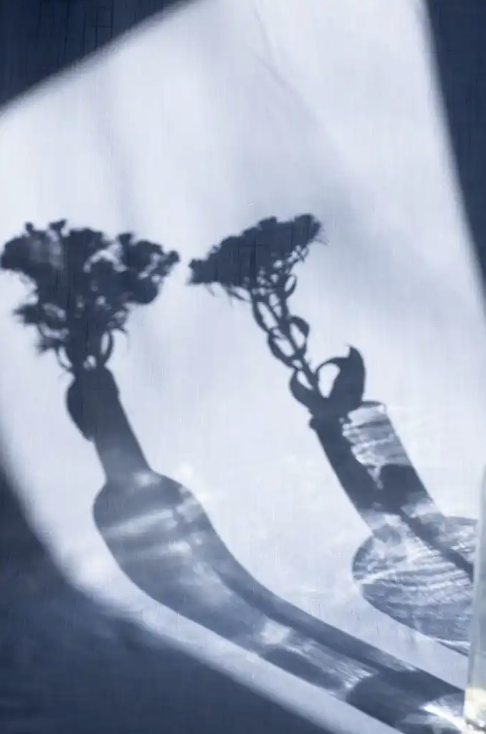
By Sakshi Rajani Age: 17 Country: India Female genital cutting (FGC): the term sounded ruthless the first time I heard it. It was not long ago that I was introduced to this term. While going through my Instagram feed, I read a story about a law student who was spreading awareness about FGC, and I was clueless about what it was. Immediately I searched this issue online and learned how serious it was. Then, I pondered why I hadn’t known about it earlier. Why had no one around me talked about it? Upon researching it further, I came to know how deeply rooted this problem was in communities and cultures. My will to do something to end it became stronger. I looked for organisations working to end FGC and came across Sahiyo. I soon joined the organisation. The first time I spoke about FGC to my friends they said, “What is that?” I wasn’t surprised by their reaction because I, too, was unfamiliar with it. I asked them to research it on their own, and then I explained more about the harms. I told them the World Health Organization and the United Nations declared FGC a human rights violation. Then I introduced them to the groundbreaking Mumkin app created by two co-founders of Sahiyo, Priya Goswami and Aarefa Johari, where my friends could learn more valuable information about this issue. What are the hurdles in encouraging abandonment of or ending FGC? FGC is also often seen as a necessary ritual for initiation into womanhood and can be linked to cultural ideals of femininity, purity and modesty. A strong incentive to continue the practice is family pressure to adhere to conventional social norms. Women who break from this social norm can face condemnation, abuse and rejection from family or community members. Patriarchal society can help perpetuate it generation after generation. Female genital cutting should stop immediately, as a woman should have full rights over her body and no woman should be harmed because of societal norms and expectations. I am now an advocate to make sure FGC ends.
Why one Bohra woman shared her experience with female genital cutting publicly
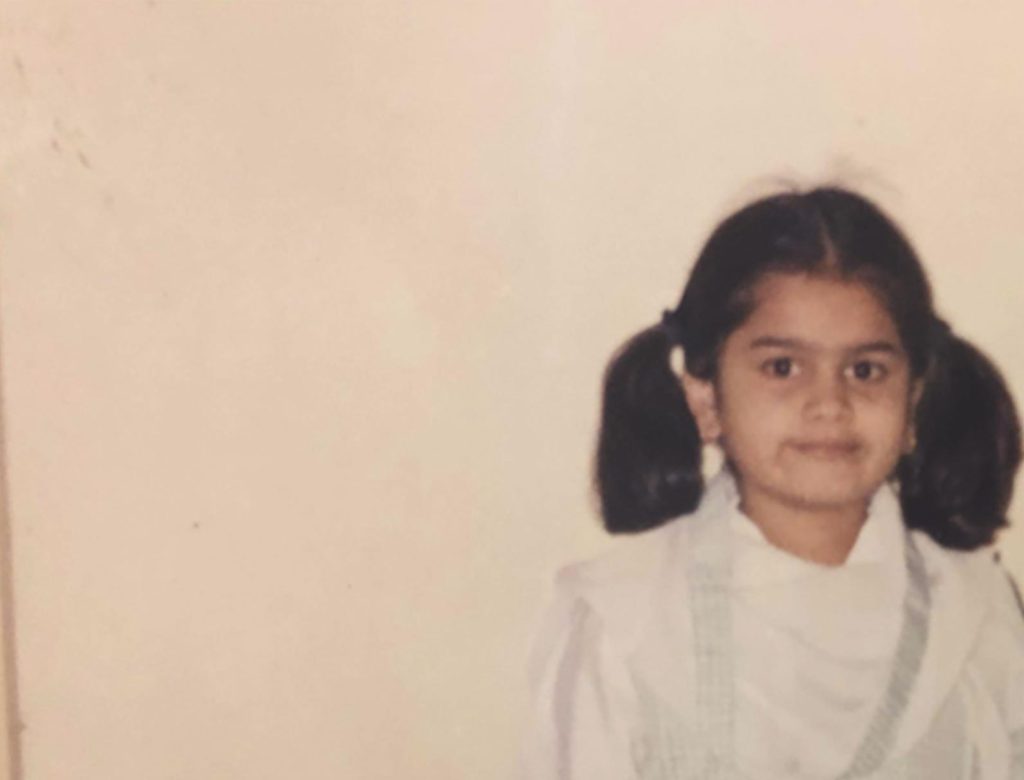
By Jenny Cordle On February 5th of last year, one day before the International Day of Zero Tolerance for Female Genital Mutilation/Cutting (FGM/C), Zahra Khozema, 24, shared her deeply personal story of having been cut as a member of the Dawoodi Bohra sect in Pakistan. “Being part of the Bohra community is feeling like a part of something,” Khozema said. “Though we are scattered around the world, we’re tightly knit. You can find a Bohra person in a crowd because of the colorful ridas women wear. And I promise you even if you don’t know them, they will approach you. I could be stranded in any city, and if I saw a Bohra person (from their clothing) I would sigh in relief because I know they’d let me in their home, or help me in any way they could. We’re a big family and we refer to everyone as brother and sister.” Despite being considered a progressive community, many members of the Dawoodi Bohra sect of Shia Islam still prioritize female genital cutting, or khatna, for girls as young as 7 years old. The Dawoodi Bohra population comprises up to one million people in countries such as India, Pakistan, Yemen, Kenya, Egypt, Tanzania and South Africa. Diaspora communities also live in Europe, Australia and the United States. “I hate that even though our community does so much good work, it’s small and not mainstream, and we’re only going to be remembered for this practice by people who don’t know Bohras in real life,” she said. Khozema, who currently resides in London, said this in reference to the 2018 U.S. case of a Michigan doctor, Jumana Nagarwala, who was initially charged with performing FGM/C on at least nine girls with the alleged help of Dr. Fakhruddin Attar, his wife, Farida Attar, and five other residents of Michigan and Minnesota. Judge Bernard Friedman dropped the FGM/C charges, declaring the 1996 federal ban on FGM/C as unconstitutional, in what pro-khatna people may have considered a victory. But on January 5th of this year, the H.R. 6100-STOP FGM Act was signed into law criminalizing FGC in the U.S., stating that religious or cultural beliefs may not be used in defense of the practice. It was in reading about the 2018 case that Khozema realized that what happened to her was a source of buried trauma. “I will never stand by the practice, but I’m glad the case was an awakening for many Bohras like me to really think about the way we treat girls and women and why — because so many men didn’t even know about it,” she said. “A couple of my Bohra guy friends told me they stopped coming to the mosque after they read this story because they only found out about it then. These are men in their mid-twenties. That alone says a lot.” Because of the secrecy surrounding the practice, Khozema was hesitant to share her experience with anyone. Her younger sister discouraged her from writing it altogether. But Khozema felt an urge to share it, despite potential repercussions. Many outspoken FGM/C activists face significant backlash within the Bohra community. This backlash can entail being ostracized, shamed, or having internet trolls harass those that speak out, claiming that speaking out is a “defamation of the faith, its leader and those who practice” khatna. Her piece was one of the top 50 stories of the year for Broadview Magazine in 2020. As she suspected, many women sought her out to share their stories of having been cut. “I wasn’t that surprised because 90% of the women I know have been through it,” Khozema said. “I was surprised that they just responded to my story positively. Non-Bohra friends assured me that this happens a lot in their own countries like India and Egypt.” “A lot of people called me brave and strong for putting such a personal topic out there, but I honestly didn’t think it was,” she said. “I felt quite small and vulnerable, and even petty for not sharing it with the people who needed to see it the most — Bohra people my parents’ age.” Khozema does not encourage women to share their stories if they are not ready. Instead, she encourages women and men to open up dialogue about khatna within their communities. “I would encourage Bohra men and women to talk to their parents, and most importantly, new moms of girls,” she explained. “Ask them if khatna is something they’re considering and really ask why. ‘Do you really know why you’d do it to your daughter or are you just following blind tradition? Are you really willing to take your child to someone with scissors in a dark basement?’” She said writing and sharing the piece did help her to heal in a sense. “I spoke to so many people who assured me it was okay to write this,” Khozema said. “I also learned to face that some people will always be okay with it, and to know when to stop fighting with people who have made up their minds.” After having written and shared the piece publicly, Khozema is in a better place and feels “lighter.” But psychologically and physically, the harm remains. “Intimacy, unfortunately, will always be difficult for me,” she said. “The shame I feel about not fully having control of my body will always be there.”
ખતના ના ખૂનથી લથબથ હાથ અને એ દીકરીઓની ચીસો ક્યારે પોહચશે આ સમાજ સુધી?
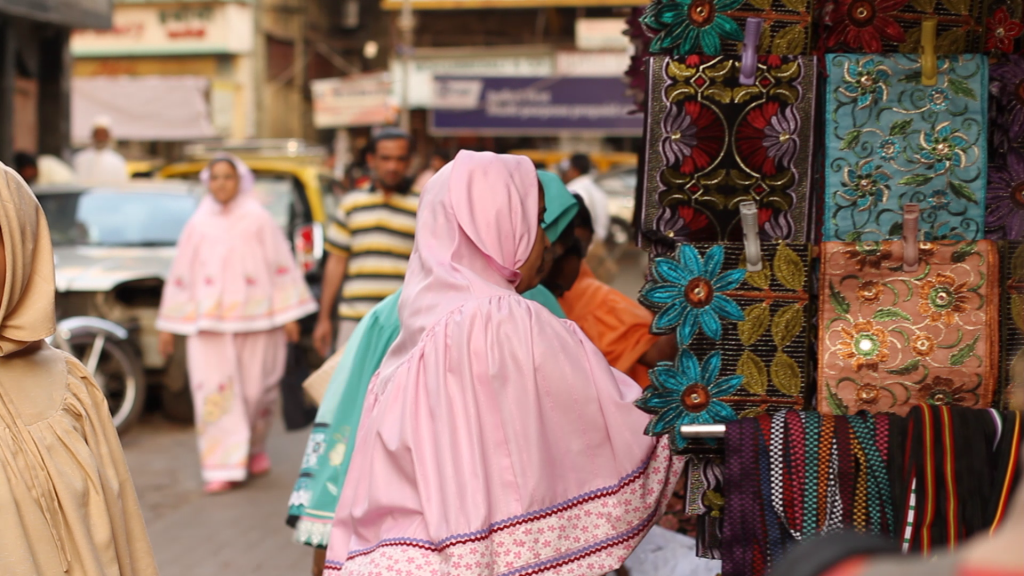
લેખક: અનામિકા ગુજરાત (લેખિકા ગુજરાતના એક સુસંસ્કૃત ગ્રામ્ય માહોલામાં જન્મ લઈને ગુજરાતના એક મોટા શહેરમાં દાઉદી વહોરા સમાજમાં પ્રવર્તી કુપ્રથાઓ અને કુરિવાજો સામે બંડ પોકારે છે. સ્ત્રી સમુદાયમાં પોતાનો આવાજ શબ્દો ચોર્યા વગર વ્યક્ત કરવાની હિમત અને ક્ષમ્તા ધરાવે છે.) દાઉદી વ્હોરા સમાજની માફક આફ્રિકાના અમુક દેશમાં નાની ઉમરની છોકરીઓની સુન્નત થાય છે. પરંતુ છેલ્લા 20 વર્ષોમાં આફ્રિકન દેશોમાં આ વિષે હવે જોરસોરથી આવાજ ઉઠવાય છે. તો ભારતમાં સૌથી સમૃદ્ધ અને શિક્ષિત ગણાતા વ્હોરા સમાજમાં હજુ આ વિષે સ્ત્રીઓ કેમ બોલતી નથી? આ માટે એક સુન્નત/ખતના પીડિત ગુજરાતની શિક્ષિત વહોરા મહિલા તરીકે મેં મારો અવાજ બુલંદ કરવાનું નક્કી કર્યું છે. હું મારા પુરુષ પ્રધાન સમાજ અને ખાસ કરીને મારા ધર્મગુરુ વર્ગને પૂછવા માંગુ છું કે, શું વહોરા દીકરી પર સાત વર્ષની ઉંમરે થતો આ એક પ્રકારનો પુરુષ પ્રધાન બળાત્કાર નથી? કુદરતે જે શારીરિક રચના, જેને માટે નિર્ધારિત કરી છે, તેનો યથાતથ (જેમનો તેમ) ઉપયોગ શુ તે માટે જ ના થવો જોઈએ? હવે તો મને પણ સવાલ થાય છે કે કુદરતે એ અંગજ શુ કામ બનાવ્યું હતું? ક્યારેય વિચાર્યું છે, અનુભવ્યું છે, એ દીકરીઓ પર નાની ઉમરે શારીરિક અને માનસીક કેવા આઘાત જીરવતી હશે? એ ડર કે શરમના લીધે ભલે બોલે નહિ, પણ આખી જિંદગી તેની તેને પીડા થતી હોય છે. મને તો એવો પ્રશ્ન પણ થાય છે કે શું વ્હોરા સમાજના પુરષોમાં પોતાની પત્નીને શારીરિક સુખ આપવાની શક્તિ કે ક્ષમ્તા નથી? મને તો એવું લાગે છે કે પુરુષના સુખ માટે અને ધર્મગુરુના આદેશ ને વશ થઈને ડરના લીધે માતાઓ દીકરીઓ સાથે આ અત્યાચાર થવા દે છે. જેથી પુરુષ તેની દુર્બળતા છુપાવી શકે. જો આ શબ્દોથી પુરુષ જાતને માનસિક ઠેસ પોહચતી હોય, તો તેણે એટલું તો જરૂર વિચારવું જોઈએ કે એક સ્ત્રી ઉપર તે પોતાનું પ્રભુત્વ સ્થાપવા મઝહબના નામે અને પોતાના આનંદ માટે અત્યાચાર કરે છે. દાઉદી વ્હોરા સમાજમાં સ્ત્રી ખતના/સુન્નત વિષે લાંબા સમયથી વિવાદ ચાલી રહ્યો છે, યુનાઈટેડ નેશન્સનું ભારત સરકાર પર દબાણ છે, કેટલીક ક્રાંતિકારી યુવા મહિલાઓએ ધર્મગુરુ દ્વારા પ્રોત્સાહિત કરાતી આ બિનઆવશ્યક નઠારી પ્રથાનો વિરોધ કરવા ઝંડો ઉપાડ્યો છે. આ કુપ્રથા પર પ્રતિબંધ મુકવા સુપ્રીમ કોર્ટની મધ્યસ્થી ચાહતી એક અરજી, સુનાવણી માટે પેન્ડીંગ પડી છે. મારે તો કહેવું છે કે સમાજની તમામ સ્ત્રીઓ એ આવાજ ઉઠાવો જ જોઈએ. ક્યાં સુધી વેહમો અને અંધશ્રદ્ધાના નામ પર આવી કુપ્રથાના ગુલામ બની રેહશો? તમારી સાથે જે અત્યાચાર થયો તે હવે પછીની સમાજની કોઈ પણ દીકરી સાથે ના થવો જોઈએ. ઘરના બુજુર્ગ, ખાસ કરીને મહિલાઓ, ના માને તો માતા-પિતાએ તો પોતાની દીકરી માટે સજાગ થવુ જ જોઈએ. મારી દીકરીને આ કુપ્રથામાથી બચાવી લેવા મારા કુટુંબ સાથે મેં જબ્બર સંઘર્ષ કર્યો અને હું હારી ગઈ. હું આ લખી રહી છું ત્યારે પણ મારા રૂવાડા ઊભા થઈ જાય છે. મારી નજર સામેથી મેં મારી સાવ અણસમજ દીકરી સાથે આચરેલી દુષ્ટતા માટે મને ખુબ પસ્તાવો પણ થઇ રહ્યો છે. મારી દીકરીની અને મારી ખુદની ચીસો મારા કાનમાં હજુ પણ ગુંજે છે, ક્યારેક રાતે ઉઠીને પસ્તાવો કરું છું. મે મારા પતિને ખૂબ સમજાવ્યા પણ તે ગુલામ માનસિકતા ધરાવતા અને ડરપોક નીકળ્યા, હું હારી ગઈ મારી દીકરીની સામે. આજે જ્યારે પાછુવાળીને ભૂતકાળને યાદ કરું છું, મારા ભાગ્યને દોષ આપું છું, મારી જાતને પૂછું છું, હું દીકરીને લઇ ભાગી કેમ નો ગઇ? જો આમ કર્યું હોત તો આજે આ મનસ્થિતિનો માનસિક શિકાર ન બની હોત. હું નથી ખુદને માફ કરી શકતી, ના મારા પતિ કે પરિવાર ને. પરિપક્વ થયેલી મારી દીકરી આજે મને પૂછે છે “માં મારી સાથે તે આવું શુકામ થવા દીધું?” આજે પણ હું મારી જાતને ગુનેગાર ગણી મૂંગી થઇ જાઉં છું. હું પણ મારી મને પૂછતી હોઉં છું કે કેવી પીડા અને દર્દ મેં સહન કર્યું હતું એ વખતે. કેટલું લોહી જીવતા અંગના છેદનથી વહી જાય છે, કેવી જહ્ન્નમી પીડા થાય છે, તે ક્યારેય આ ધર્મગુરૂઓ કે પુરુષો શું સમજી શકે છે? નહિ સમજે માં નહિ સમજે એ લોકો. સ્ત્રીઓ તો મૂરખાની જેમ ગુલામ બની જીવમાં પોતે બહુ ધાર્મિક છે તે દેખાડવામાં બધું ચુપચાપ સહન જ કરે રાખે છે. અને પાછી તે વાતનો ગર્વ લેતા પણ શરમાતી નથી. આ વાત એક દીકરીને સમજાય છે. શું કહવતા પ્રગતિશીલ ગણાતી વોહરા કોમને આ વાત સમજાય છે? મારો આત્મા મને દરરોજ ઢંઢોળે છે, હચમચાવે છે. ક્યાં સુધી અંધશ્રદ્ધા અને વેહમના નામે કેટલીએ માસૂમ દીકરીઓનો આ સમાજ ભોગ લેશે? મારા સમાજને હું પૂછું છું. ખાસ કરીને સમાજના પુરુષોને કે ક્યારેય વિચાર્યું, આ ગંદી માનસિકતા અને ગંદો રીવાજ ક્યાંથી કેમ આવ્યો? ક્યારેય મૂળ સુધી પોહચવાનો પ્રયત્ન કર્યો? મને સુપર મોડેલ વારીસ ડીરીનું પુસ્તક “ડેજર્ટ ફ્લાવર” યાદ આવી રહ્યું છે. તેણે લખેલો આફ્રિકન ઇતિહાસ જોશો તો, તમારા રુવાડા ખાડા થઇ જશે. આફ્રિકન સ્ત્રી બાળકો પર કેવી બર્બરતા આચરવામાં આવી રહી છે. તેનું તાદ્સ વર્ણન આ પુસ્તકમાં કરવામાં આવ્યું છે. આ પુસ્તકે આફ્રિકન સમાજમાં ક્રાંતિ આણી છે. આફ્રિકન સમાજ હવે આ કુપ્રથામાંથી બહાર નીકળવા લાગ્યો છે. યુનાઈટેડ નેશન્સને તેની નોંધ લેવાની ફરજ પડી છે. હું હવે જે વાત કહેવા જઈ રહી છું, તેના પુરાવા મળી જશે. ભારત પર વરમાર બહારથી મુસ્લિમો ચઢાઈ કરતા તે આપણે બધા જાણીએ છીએ. તે દરમિયાન તે વચ્ચે આવતા ગામો અને સ્ત્રીઓને લુંટતા. આ વાત જગ જાહેર છે. પુરુષને તેનું પુરુષતત્વ, સ્ત્રી પર અત્યાચાર કરી ને જ તો દેખાડવું હોય છે. સદીઓથી એમજ થતું આવે છે. વારંવારની ચઢાઈ પછી ત્યાં લૂટવા જેવુ કાઇ નથી તેની સાબિતી રૂપે સ્ત્રી નું નાક અને જનાનાંગ વિધતો, આ સચ્ચઈ છે. એટ્લે તો આપણા સમાજમાં દીકરીની સુન્નત/ખતના પછી સ્ત્રીઓ, નાક વીંધ્વ્યુ તેમ બોલતી. આ તમને યાદ હશે જ? અને પછી જ નાક વિન્ધવામાં આવતું. ત્યારની અવદશા અને માનસિક પીડા દીકરીઓને કદી ભુલાતી નથી . આજની યુવા પેઢીને આની જાણ નહીં હોય. કેમ કે તે સંપૂર્ણ ગુલામી સાથે મોટી થઈ છે. આપણી સ્ત્રીઓ ખત્નાની માફક નાની બાળકીનું નાક પણ વીંધતી. કેમ હવે નાક વીંધવાનું બંધ થયું? બસ ઉપરથી ધર્મગુરુનો આદેશ થયો એટલે માની લેવાનું? કેમ વિચાર ના આવ્યો? આપણાં સમાજમાં ચૂક પેહરવાની પ્રથા બંધ કરવામાં આવી, ધર્મગુરુના આદેશ આવ્યા પેહલાથી જ મે ચૂક/નથ પેહરવાનું બંધ કરેલુ. પુસ્તકોનાં વાંચન દ્વારા તે સચ્ચઈની મને ખબર પડી હતી. તેને સુહગની નિશાની ગણાતી. સાવ અચાનક તે નાકનું ઘરેણું પેહરવાની મનાઈ થઈ ગઈ. આ વાતને આપણે સ્ત્રી સુન્નત/ખતના સાથે ચૂક પેહરવાનુ બંધ થય શકતું હોય તો આ ભયાનક ખતના પ્રથા બંધ થવી જ જોઈએ. એ જોડીને જોવાનું કેમ નથી વિચારતા? આને હું માસૂમ બાળકીઓ ઉપર કાયદેસરનો બળાત્કાર/રેપ જ ગણું છું. મને દાઉદી વહોરા સમાજના પુરુષો પ્રત્યે ધૃણા/નફરતની લાગણી
Crying out our mothers’ grief: How we allowed female genital mutilation to flourish in our communities

By Tamanna Taher When I began writing an article on female genital mutilation (FGM), I was adamant that my research be thorough, and my opinions be carefully articulated. However, I did not realise the mammoth task the latter would become. It has been two years since I started writing this article. I was a sophomore in college when I began, and I sit here as a senior, writing to pledge my solidarity to end FGM. My parents had managed to shield me from the hushed conversations that I always knew were happening. I was 14 years old when I was finally let into the discussions recounting personal experiences and stories from survivors in the family. I remember sitting in the backseat of my parents’ car, asking what they were whispering about. My father said it was okay to tell me, and explained FGM, or khatna, as it is known in the Dawoodi Bohra community. “It is when a female is circumcised.” “Circumcised? How? What?” “They (carefully separating us and them), believe that for a woman to be pure, she must undergo a surgical procedure in which she is circumcised.” “Oh.” At this moment, I was as any teenager finding out about such an issue would be – very uncomfortable. Deciding not to ask anything else, I sat back and wondered what exactly was there to be circumcised down there. This went on for a few very silent weeks. However, I finally mustered enough courage to ask the question that had been haunting me. Had it been done to me? I remember awkwardly questioning my mum one day, asking whether I was so young that I did not even remember. She informed me that she was vehemently against it, and neither me, nor my sister, had this procedure done. She said she would never, as she was a victim of it herself: a victim of family traditions and beliefs, and another one of the countless victims of groupthink. She said that she remembered her experience, and it was not something a woman forgets. She was seven years old. My mum never called herself a victim. She told me that she had never understood it fully. At the time she drew a parallel between being cut and getting an ear piercing. That is why, she explains now, she never questioned her mother. That is why she believes her mother never questioned my great grandmother. She thought of it as a necessity of growing up – not a religious doctrine, but a cultural tradition. I have chosen the words victim and survivor very purposefully. I believe if this had truly been something she did not feel was an injustice to women around the world, my mother would have chosen us to carry the burden of the tradition. But she stepped back, separating herself from the powerful clutches of “Log kya kahenge?” (“What will people say?”) She saved her daughters from the injustice she was too young to save herself from. I will forever be grateful to my mother, for being so brave and standing up against members of the family she loved and trusted, fighting them and protecting us from the practice that she had to suffer from herself, of which countless others still have to suffer the consequences. I began asking the women around me whether they had been subjected to any form of FGM. I was appalled at how many of them said yes. I was even more revolted when I found out that my family had been divided by this issue. There were people around me that agreed with what was happening, so much so that they decided to boycott all the members of the family who saw FGM for what it was – child abuse. This was a confusing time for me. I was very close to a cousin of mine who defended the right to have been cut. She saw it as something that should be a choice. I was almost swayed by her. I regret that I allowed that to happen, and I am embarrassed that I did not realise sooner the repercussions of staying silent in such situations. I see now that khatna is not a choice. The girls who are cut are not consenting. They are usually ignorant about what is being done to them – realising the effects only in adulthood, and at which point they must silently bear the psychological pain and trauma. A girl, in the moment, might only feel the excruciating pain of the instrument being used to perform the procedure, but when she becomes a woman, she will realise that the cuts run deeper than what she previously thought. This is why so many people have begun to speak up. This is exactly why Sahiyo – United Against Female Genital Cutting as an organization exists. Children cannot make these decisions, and you cannot legally call them consenting beings. They do not have full knowledge, and they do not realise the gravity. To anyone who argues otherwise, I would like to present several stories. One of the women I spoke to told me that she had been promised ice cream if she went. She was only 8 years old; an adult would recognise that as manipulation. Another told me that her mother said she was going to see a doctor because she was sick. That is universally recognised as deceit. I even had someone tell me that her mother had slapped her and told her that she was doing this for God. That is plain and simple coercion. But, most importantly, all of the above is child abuse, manifesting in its verbal, emotional and physical forms. You might be thinking, but what will speaking up do? We need you to understand that every voice matters because we are speaking for those that had been stripped of theirs. You may also be thinking there is so much awareness. The number of girls subjected to this must be falling. That is far
Conversations with my mom about khatna and betrayal
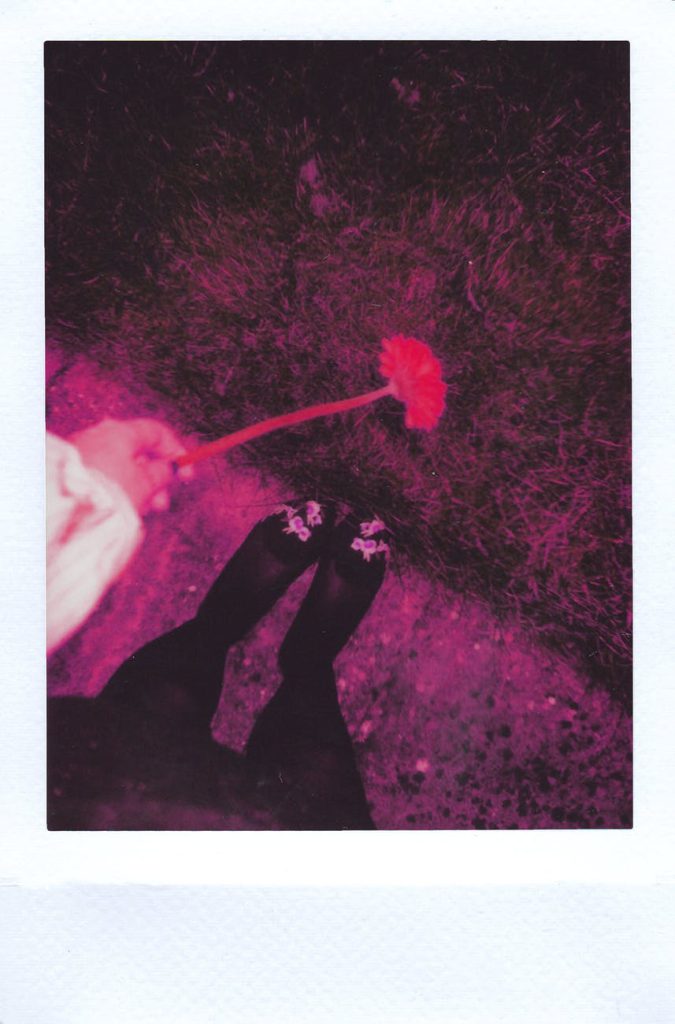
By Zahara Kagalwalla I am a chatty person. I call up my best friend and prattle to him even about the most mundane development in my life like the latest teatime snack I gobbled (muesli, definitely a poorly thought out choice). So when I am distressed, there is furor on the phone. Despite my love for babbling and our nine years of friendship, Phiroze did not know about my khatna experience, or female genital cutting, until very recently. I preferred to tuck it away in a corner of my brain because if I don’t acknowledge it, I can avoid processing the trauma. When I departed for university, things changed. I picked up a gender studies major and began learning about concepts such as informed consent and an individual’s right over their own body. This made me more and more uncomfortable with my “ignorance is bliss” policy. The trauma that I had successfully managed to bury in my subconscious emerged, and I finally began the journey toward understanding what happened to me ten years ago. Simply, I was cut, and I don’t like it. In fact, I was infuriated. One fine day, I decided to dial-up my mom and have a conversation, but really it wasn’t a conversation. I went in ready to pick a fight. I was the victim and my mother was the perpetrator. How could you? My accusatory tone coupled with my hot tears put her in defensive mode. She justified her actions: “We took you to a doctor, not to an unqualified middlewoman in Bhendi Bazaar. You experienced no pain.” “Khatna doesn’t affect your life; it is ritualistic.” “Maasi, I, and aunty have all undergone khatna. We are just fine even thirty years later.” With emotions running high, I was unable to communicate my point. Whether it hurts or not, whether the procedure was done in a doctor’s clinic or not, nothing changes the fact that it is my body and my rules. This definitely wasn’t a conversation. Two years later, I realized that I left empathy at the doorstep during my first discussion about khatna with my mother. I disregarded that she came from a place of love, and she never intended to cause me any harm. I did not even bother to understand the kind of social pressure she faced from my extended family, and how her expressions of discomfort with the ritual were severely squashed. I failed to acknowledge the constant guilt she lives with for compelling her daughter to partake in a primitive tradition, particularly when she witnesses my personal struggle toward self-acceptance. She fought for me, but the tremendous social pressure did not let her win. Always uncomfortable and unsure about the ritual, my mother has now taken a stance against it. She couldn’t protect me, but she will protect her future granddaughter. Now we fight against khatna together, confident that my daughter will not face female genital cutting.
